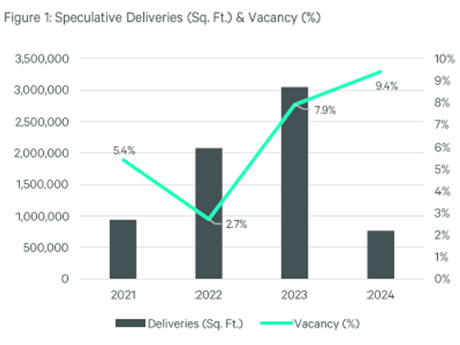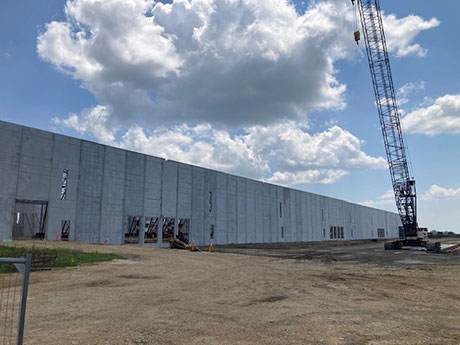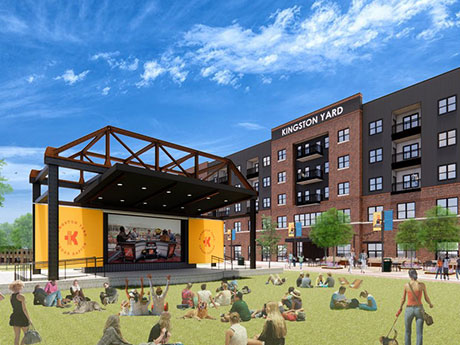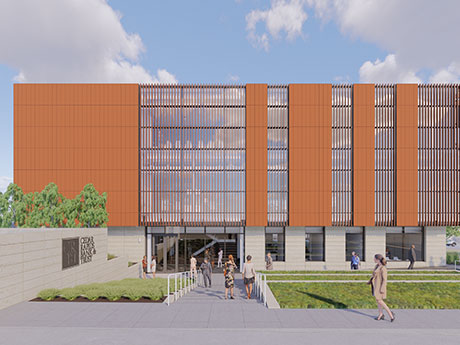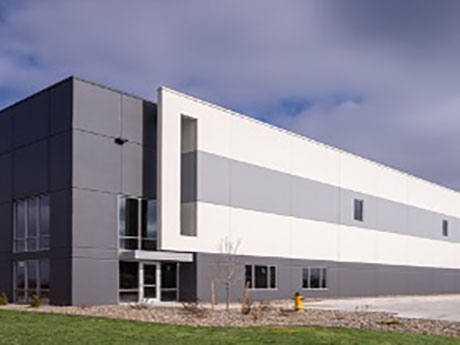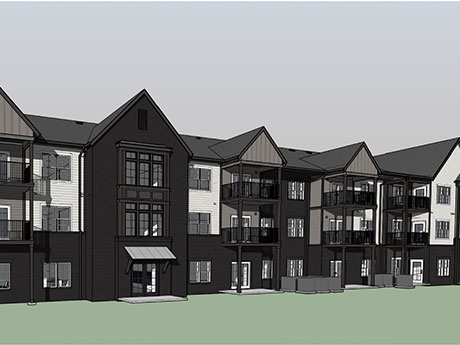By Harrison Kruse and Ned Turner, CBRE As we near the second half of 2025, the Des Moines industrial market is starting to see a shift in fundamentals, as new deliveries and the pipeline of new big-box speculative warehouse product have come to a complete halt. Like many cities in the upper Midwest post-COVID, the Des Moines MSA saw an influx of out-of-state developers backed by institutional capital go ground up with new big-box product when the economy was stimulated by the Federal Reserve reducing the federal funds rate below 1 percent. This resulted in historically compressed treasury yields and an abundant amount of liquidity injected into the capital markets. This effect on the national economy escalated consumer demand for e-commerce and locally, ag-related products, which are the state of Iowa’s most valuable export on an aggregate basis. The Des Moines MSA between 2021 and 2024 had more than 6.8 million square feet of new industrial space delivered to the market, which is about 10.2 percent of the total market size on a square-foot basis. During those years, net absorption increased on an annual basis between 800,000 and 1.5 million square feet. Pre-COVID, Des Moines’s average net absorption was between …
Market Reports
By John G. Ruhl, NAI Ruhl Commercial Co. People are always surprised when they learn how many communities are part of the Quad Cities since they think it stops with just four towns. For the record, there are 58. The bi-state region includes Moline, East Moline and Rock Island, Illinois, and Davenport and Bettendorf, Iowa, as the main core cities. The Quad Cities is the largest metro area between St. Louis and Minneapolis on the Mississippi River. The Mississippi River was the main reason for this region’s initial growth historically since it was an important distribution channel. John Deere moved his base of operation to Moline, Illinois, in 1848 to utilize the river’s power for manufacturing and transportation of goods. The world headquarters of Deere & Co. are still based here, along with many of its factories and distribution centers, making it the region’s largest employer. Several other Fortune 500 companies have a major presence in this region, including Arconic, 3M, Nestle-Purina and Kraft Heinz. The Quad Cities has always been led by smaller manufacturers, suppliers and service providers supporting our major employers and the regional economy. More than 1,200 manufacturers from all industry sectors are based in the …
By Scott Olson, Skogman Commercial As the city of Cedar Rapids, Iowa celebrates its 175th year in 2024, the growth momentum and success continues despite a derecho, pandemic and high interest rates that have impacted the state and our nation. The city continues to reach new heights, becoming one of the few communities in the nation to have all of its major city service departments obtaining accreditations from leading industry-specific agencies. Currently, the departments certified include: • Parks and Recreation Department • Fire Department • Police Department • Public Works • Public Library • Building Service Department Code • Enforcement Division Public Works passed accreditation with a 100 percent score with 11 of its policies selected to be used as models for other cities. The Code Enforcement Division had the highest score to date and is only the ninth city to have this certification. But, just as impressive is the city’s most recent national rankings: • No. 23 city with the lowest cost of living in America (niche.com, 2024) • No. 41 best place to live in America (livabililty, 2024) • No. 45 happiest city in America (wallethub, 2024) • No. 13 best city to buy a house …
By Scott Olson, Skogman Commercial Despite a derecho, a pandemic, inflation, supply chain issues and a possible recession, Cedar Rapids continues its rapid growth as evidenced by the ranking by “American Growth Project 2023” as a top 15 fastest-growing mid-size U.S. city. But, its other national rankings are just as impressive: • 23rd-Best Run City in U.S. (wallethub.com, 2023) • Top 100 Best Places to Live in America (Livability, 2023) • 23rd-Best Place to Raise a Family (wallethub.com, 2023) • 13th-Best City to Buy a House (niche.com, 2023) • Ranked No. 21 of Cities with Lowest Cost of Living (Business Insider, 2023) • A Cleanest U.S. City by Short-Term Particle Pollution (American Lung Association, 2023) • Two Nationally Ranked Medical Centers: St. Luke’s Hospital and Mercy Medical Center (PINC Al/Fortune and Newsweek, 2023) • Top 50 Best City for Jobs in America (wallethub.com, 2023) • No. 22 Safest City in America (wallethub.com, 2022) • Best Tasting Drinking Water in Iowa (Iowa Section, American Water Works 2022) In addition to these rankings, Cedar Rapids is also continuing to make major progress on recovery from previous national disasters: • 2008/2016 historic floods are resulting in the $750 million flood control system making …
By Jeremy Spillman and Corey Sedrel, Capstone Commercial In a setting where I-80 and I-35 intersect to make up one of the busiest truck traffic intersections in the Midwest, Des Moines is well positioned to harness the power of manufacturing in Iowa to support several larger Midwest cities such as Chicago, Minneapolis, Kansas City, St. Louis and Omaha. As we see change in our global supply chains, manufacturers and distributors look to states like Iowa to support these changing environments where we see these organizations moving away from the just-in-time model to just-in-case. The transition to a just-in-case supply chain model began to form due to several supply chain-related issues we encountered during the pandemic. This led to higher demand for additional warehousing to be constructed. Availability of large cube warehousing had been historically tight in Iowa since 2012 where most years carried vacancy rates of 2.5 to 4.5 percent annually. During 2022, there was 2.97 million square feet of warehouse/distribution space delivered to meet the increase in demand of rising inventories. “From the construction standpoint, supply chain issues are subsiding, but there are still longer than normal lead times for certain trades and equipment. These lead times are still …
By Douglas Laird and Karl Hoffman, Skogman Commercial Realty Last year’s article on Cedar Rapids began by describing the 2020 Derecho windstorm that brought major damage to Iowa. This included our entire city of Cedar Rapids — an area of 75 square miles. There has been good progress toward recovery; yet many homes and businesses are still in need of repair. In addition, both individuals and companies confront inflation, energy costs and unpredictable consumer costs and shortages. In spite of these hurdles, however, the growth in the multifamily, residential and industrial sectors matches national trends. National rankings are exemplary for the city of Cedar Rapids: • No. 10 in “Best Cities to Buy a House in America” • No. 18 in “Cities with the Lowest Cost of Living in America” • No. 3 in the list of “Top 20 Fastest Metro Areas to Save for Your First Home” The multifamily sector has many exciting new projects in the pipeline totaling over $100 million. Here are just a few: • First on First West: a mixed-use site along First Avenue West • Loftus Lumber site: a five-story building with 186 market-rate units • KCG Development at Jacolyn Drive SW Land sales …
By Chris Curran and Alexa Strickler, R&R Realty Group It’s no secret that the past couple of years have been dramatically different for us all. We’ve had to adjust to new routines, new practices and new ways of getting work done. Some of these new things will be here to stay while others have already receded into memory. No matter the amount of change though, one thing remains the same. That’s the need for human connections and relationships. And, ultimately, that’s what physical office space provides. It seems many organizations are starting to understand just how valuable this connection truly is. Across various submarkets within the Des Moines metro area, companies large and small are returning to in-person work. And it’s not just existing customers returning to their spaces. There has been a marked uptick in office leasing activity in locations ranging from downtown to the western suburbs. From advertising agencies to accounting firms and more, the vacancy rate across the entirety of central Iowa is beginning to be chipped away. Why are so many companies across a wide variety of industries heading back to the office? Well, like we mentioned earlier, there’s a sense of connection and an ability …
By Ryan Kelly, TWG Development Despite the affordable housing crisis, Des Moines has managed to endure the adverse factors that have caused a boom in housing prices nationwide — but we still have a ways to go. A sustained demand, an influx of business and new projects by national developers all played a role in Des Moines’ multifamily growth over the past two years. Developing Des Moines Home to some of the largest multinational finance and insurance corporations, Des Moines has pioneered Iowa’s growth. The city has also seen population growth — the most recent census revealed that Des Moines’ suburbs led to Iowa’s development while the city itself grew by 5.4 percent. Des Moines is the 10th-best place for business and careers, according to Forbes, and ranked as the fifth-best city to live in, according to U.S. News and World Report. The capital city has experienced a boom in employment, with a rise in the number of high-tech jobs, at a 6.7 percent rate. The Midwest’s low cost of living (7 percent lower than the national average) and Des Moines’ proximity to large cities have contributed to the growth of key industries, including logistics, ag-bioscience, manufacturing, data and insurance. …
By Scott Olson, Skogman Commercial On Aug. 10, 2020, eastern Iowa was hit with a derecho. This is the Spanish word for a widespread, long-lived, straight-line windstorm that is associated with a fast-moving group of several thunderstorms. Winds in southwest Cedar Rapids were estimated to be 140 miles per hour with the entire city of 75 square miles sustaining major damage. The statistics are staggering: • Cedar Rapids lost 669,000 mature trees, about 70 percent of its urban canopy. The storm left at least 4.5 million cubic yards of debris. Stacked 35 feet tall and wide, it would extend a whopping 24 miles. • 6,000 homes and properties were damaged. As repairs and reconstruction got underway, the city issued 25,000 building permits in fiscal-year 2021, more than double the number in a typical year. • City government buildings suffered $20 million in damage, while the business community reported losses totaling $170 million. About $70 million of that was the result of derecho-related shutdowns or power outages. • The state cumulatively sustained $11.5 billion in damage, according to the National Oceanic and Atmospheric Administration, which calls the Aug. 10 derecho “the costliest thunderstorm in U.S. history.” However, as evidenced in the …
By Chris Curran and Mark Mills, R&R Realty Advisors Would you rather earn more money or have a more flexible work/life balance? Before the pandemic, many employees gave the latter as their answer. But the amount of money employees claimed they would forego wasn’t exactly peanuts. According to a pre-pandemic study by career site Joblist, the average employee was willing to give up around $10,000 per year to have better work/life balance. Fast forward to the present day and employees continue to express this desire. The isolation felt by many when working from home has increased the blurriness of the line that separates work from life. In fact, a survey conducted by TELUS International found that isolated workers reported a nearly 80 percent increase in work-related stress and anxiety when working from home. Given these findings, perhaps it shouldn’t surprise anyone that three out of four office employees express a desire to return to in-person work. If there’s a silver lining to the unprecedented year we’ve been emerging from, it may be that employees and employers alike are coming to understand the value in providing a balance between work and personal time. And, when it comes to the office market …
Newer Posts


